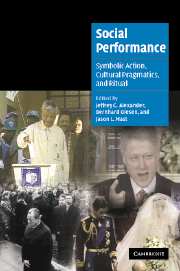Book contents
- Frontmatter
- Contents
- List of figures
- List of tables
- List of contributors
- Introduction: symbolic action in theory and practice: the cultural pragmatics of symbolic action
- 1 Cultural pragmatics: social performance between ritual and strategy
- 2 From the depths of despair: performance, counterperformance, and “September 11”
- 3 The cultural pragmatics of event-ness: the Clinton / Lewinsky affair
- 4 Social dramas, shipwrecks, and cockfights: conflict and complicity in social performance
- 5 Performing a “new” nation: the role of the TRC in South Africa
- 6 Performing opposition or, how social movements move
- 7 Politics as theatre: an alternative view of the rationalities of power
- 8 Symbols in action: Willy Brandt's kneefall at the Warsaw Memorial
- 9 The promise of performance and the problem of order
- 10 Performance art
- 11 Performing the sacred: a Durkheimian perspective on the performative turn in the social sciences
- Index
- Cambridge Cultural Social Studies
- References
1 - Cultural pragmatics: social performance between ritual and strategy
Published online by Cambridge University Press: 07 December 2009
- Frontmatter
- Contents
- List of figures
- List of tables
- List of contributors
- Introduction: symbolic action in theory and practice: the cultural pragmatics of symbolic action
- 1 Cultural pragmatics: social performance between ritual and strategy
- 2 From the depths of despair: performance, counterperformance, and “September 11”
- 3 The cultural pragmatics of event-ness: the Clinton / Lewinsky affair
- 4 Social dramas, shipwrecks, and cockfights: conflict and complicity in social performance
- 5 Performing a “new” nation: the role of the TRC in South Africa
- 6 Performing opposition or, how social movements move
- 7 Politics as theatre: an alternative view of the rationalities of power
- 8 Symbols in action: Willy Brandt's kneefall at the Warsaw Memorial
- 9 The promise of performance and the problem of order
- 10 Performance art
- 11 Performing the sacred: a Durkheimian perspective on the performative turn in the social sciences
- Index
- Cambridge Cultural Social Studies
- References
Summary
From its very beginnings, the social study of culture has been polarized between structuralist theories that treat meaning as a text and investigate the patterning that provides relative autonomy and pragmatist theories that treat meaning as emerging from the contingencies of individual and collective action – so-called practices – and that analyze cultural patterns as reflections of power and material interest. In this chapter, I present a theory of cultural pragmatics that transcends this division, bringing meaning structures, contingency, power, and materiality together in a new way. My argument is that the materiality of practices should be replaced by the more multidimensional concept of performances. Drawing on the new field of performance studies, cultural pragmatics demonstrates how social performances, whether individual or collective, can be analogized systemically to theatrical ones. After defining the elements of social performance, I suggest that these elements have become “de-fused” as societies have become more complex. Performances are successful only insofar as they can “re-fuse” these increasingly disentangled elements. In a fused performance, audiences identify with actors, and cultural scripts achieve verisimilitude through effective mise-en-scène. Performances fail when this relinking process is incomplete: the elements of performance remain apart, and social action seems inauthentic and artificial, failing to persuade. Re-fusion, by contrast, allows actors to communicate the meanings of their actions successfully and thus to pursue their interests effectively.
- Type
- Chapter
- Information
- Social PerformanceSymbolic Action, Cultural Pragmatics, and Ritual, pp. 29 - 90Publisher: Cambridge University PressPrint publication year: 2006
References
- 143
- Cited by



